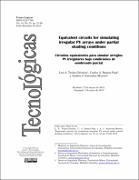| dc.contributor.author | Trejos-Grisales, Luz A. | |
| dc.contributor.author | Ramos-Paja, Carlos A. | |
| dc.contributor.author | Saavedra-Montes, Andrés J. | |
| dc.date.accessioned | 2019-07-18T14:10:18Z | |
| dc.date.accessioned | 2019-08-20T15:57:50Z | |
| dc.date.available | 2019-07-18T14:10:18Z | |
| dc.date.available | 2019-08-20T15:57:50Z | |
| dc.date.issued | 2015-08-03 | |
| dc.identifier | https://revistas.itm.edu.co/index.php/tecnologicas/article/view/187 | |
| dc.identifier | 10.22430/22565337.187 | |
| dc.identifier.uri | http://hdl.handle.net/20.500.12622/973 | |
| dc.description.abstract | El modelado y simulación de sistemas fotovoltaicos (PV) son áreas de investigación abiertas ya que las curvas I-V y P-V son comúnmente requeridas para analizar el desempeño de instalaciones PV. Para obtener dichas curvas se pueden utilizar paquetes de cómputo, sin embargo, el tipo de conexión y el tamaño del arreglo PV pueden ocasionar largos tiempos de simulación. Para superar dicha dificultad se han propuesto técnicas basadas en los puntos de inflexión para modelar el arreglo PV con el objetivo de reconstruir exactamente las curvas eléctricas requeridas. Sin embargo, tal análisis ha sido aplicado solo a la configuración serie-paralelo (SP), la cual es solo una de las alternativas para conectar arreglos PV entre otras opciones de conexión regular o irregular. Por esto, se requiere una aproximación más general. Este artículo presenta una proximación para obtener las curvas características de cualquier arreglo PV, regular o irregular, extendiendo el análisis de los puntos de inflexión. Entonces, de las curvas eléctricas del arreglo PV es simplificado utilizando circuitos equivalentes en intervalos definidos por los puntos de inflexión. Tal procedimiento está basado en definir cuáles módulos se activan debido al comportamiento de los diodos de bypass. Finalmente, la aproximación propuesta permite analizar cualquier arreglo PV sin requerir de simulaciones largas. La solución fue validada por medio de resultados de simulación obtenidos en Matlab®. | spa |
| dc.format.mimetype | application/pdf | |
| dc.language.iso | eng | |
| dc.publisher | Instituto Tecnológico Metropolitano (ITM) | spa |
| dc.relation | https://revistas.itm.edu.co/index.php/tecnologicas/article/view/187/193 | |
| dc.rights | Copyright (c) 2017 Tecno Lógicas | spa |
| dc.source | 2256-5337 | |
| dc.source | 0123-7799 | |
| dc.source | TecnoLógicas; Vol 18 No 35 (2015); 57-69 | eng |
| dc.source | TecnoLógicas; Vol. 18 Núm. 35 (2015); 57-69 | spa |
| dc.subject | Representación matemática | spa |
| dc.subject | generador PV no uniforme | spa |
| dc.subject | circuitos equivalentes | spa |
| dc.title | Circuitos equivalentes para simular arreglos PV irregulares bajo condiciones de sombreado parcial | spa |
| dc.title.alternative | Equivalent circuits for simulating irregular PV arrays under partial shading conditions | |
| dc.subject.keywords | Math representation | eng |
| dc.subject.keywords | non-uniform PV generator | eng |
| dc.subject.keywords | equivalent circuits. | eng |
| dc.type | info:eu-repo/semantics/article | |
| dc.type | info:eu-repo/semantics/publishedVersion | |
| dc.type | Research Papers | eng |
| dc.type | Artículos de investigación | spa |
| dc.relation.ispartofjournal | TecnoLógicas | |
| dc.description.abstractenglish | Modeling and simulation of photovoltaic (PV) systems are open research areas since I-V and P-V curves are commonly required to analyze the performance of PV installations. To obtain such curves commercial software packages can be used, however the connection type and size of the PV array may cause large simulation times. To overcome such an issue several techniques based on analyzing the inflection points have been proposed to model the PV array with the aim of reconstruct accurately the required electrical curves. However, such analysis has been applied only for series-parallel (SP) configuration, which is just one alternative to connect PV arrays among several other regular or irregular options. Therefore, a more general approach is needed. This paper presents an approach to obtain the characteristics curves for any PV array, regular or irregular, by extending the inflection points analysis. Then, the calculation of the PV array electrical curves is simplified by using equivalent circuits within the intervals defined by the inflection points. Such a procedure is based on defining which modules become active due to the behavior of the bypass diodes. Finally, the proposed approach enables to analyze any PV array without requiring long electrical simulations. The solution was validated by means of simulation results obtained in Matlab®. | eng |
| dc.rights.accessrights | info:eu-repo/semantics/openAccess | |
| dc.type.coar | http://purl.org/coar/resource_type/c_6501 | |


